Australia/Israel Review
Deadly Precision
Feb 27, 2019 | BICOM
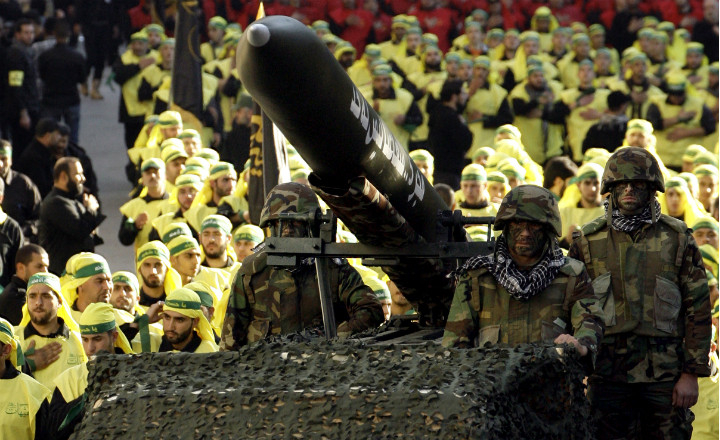
This briefing discusses how Hezbollah, with the help of Iran, is upgrading its arsenal, to convert its missiles into precision missiles with guidance systems and greatly increase its ability to destroy Israel’s military and civilian infrastructure. Israel has been warning since 2006 that Hezbollah has massively increased its stockpile of short and medium-range missiles. Yet Hezbollah’s attempts to acquire precision-guided medium-range missiles present a much more serious threat.
What is Hezbollah?
Hezbollah is an armed Shi’ite movement founded in Lebanon in 1982. It was established with the help of Iran and remains closely allied and ideologically committed to the Iranian regime. With its substantial independent armed forces – estimated at 45,000 fighters – and political base in Lebanon’s Shi’ite community, it is a key political player within Lebanon. In May 2018 Hezbollah and its political allies won 70 of Lebanon’s 128 parliamentary seats in the country’s first parliamentary elections since 2009 and Hezbollah allies now hold two ministerial positions and a ministry of state in the government.
Hezbollah – like Iran – is ideologically committed to Israel’s destruction, and gains domestic and regional legitimacy by positioning itself as part of the “resistance” against Israel. This is despite Israel withdrawing all military forces from south Lebanon in 2000. Hezbollah has played a significant role fighting in support of the Assad regime in the Syrian civil war and played a major role in the battles for Aleppo, the Qalamoun region and the Syrian towns of Zabadani and Qusayr near the Lebanese border.
What happened in the 2006 Second Lebanon War?
In July 2006, a Hezbollah raid into northern Israel – which resulted in eight Israeli soldiers killed and two captured – triggered a 34-day conflict between Hezbollah and Israel. Hezbollah fired 4,000 missiles at northern Israel, whilst Israel – which was yet to develop a missile defence system – used air and ground forces to try and destroy the launchers. Forty-six Israeli civilians were killed and the Israel Defence Forces (IDF) lost 121 soldiers. One thousand two hundred Lebanese were killed, the IDF estimates that 600-800 were Hezbollah fighters. The war ended with a UN-backed ceasefire, which mandated a strengthened UN peacekeeping force and required the Lebanese Armed Forces to deploy on the border in place of Hezbollah. However, whilst a ceasefire has mostly held since 2006, Hezbollah has not been prevented from greatly strengthening its military capabilities and deploying forces along the border with Israel.
What threat do Hezbollah’s current capabilities pose?
Hezbollah possesses approximately 100,000 to 130,000 missiles, many hidden in houses and civilian infrastructure in the villages in Hezbollah-dominated areas of southern Lebanon. Fourteen thousand are estimated to be Zelzal 2 missiles with a range of 210km. Whereas in 2006 Hezbollah fired an average of 118 missiles a day, it is estimated that it could now fire at least 1,200.
Even with Israel’s early warning and missile interception system, missiles fired at major population centres in large numbers can be deadly, forcing civilian populations to remain in or near shelters, closing schools and businesses, and paralysing normal life. Hezbollah has also developed plans for cross border raids using tunnels, six of which have recently been uncovered inside Israeli territory and destroyed in an IDF operation in late 2018.
Iran’s attempts to establish Shi’ite proxies in Syria to complement the Hezbollah force in Lebanon with a second front, also faced a major setback in 2018. Israel launched a successful wave of airstrikes against these bases, culminating in Operation House of Cards in May 2018 in which the IAF hit Iranian targets throughout Syria.
HEZBOLLAH’S GAME-CHANGING PRECISION PROJECT
Hezbollah’s ‘Precision Project’ refers to attempts by Iran to upgrade Hezbollah’s large arsenal of missiles by improving their accuracy. Commanders of the Iranian Revolutionary Guards Corps (IRGC) and Hezbollah have boasted publicly about it.
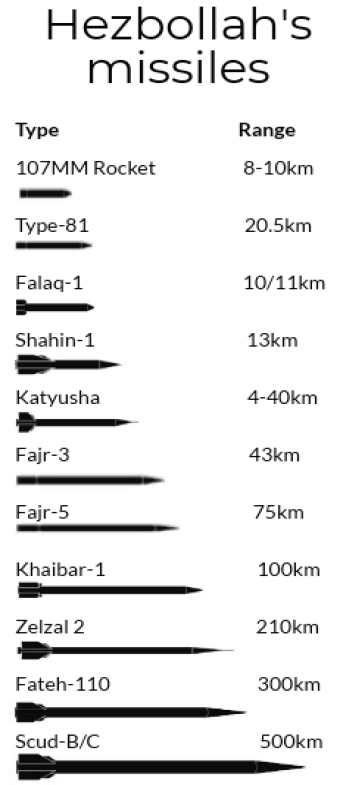 Precision-guided missiles present a far greater strategic threat than unguided missiles previously deployed by Hezbollah, because they can target key Israeli infrastructure with fewer missiles. Because of Israel’s size and concentrated population and industry, damage to a small number of key infrastructure sites – e.g. power stations, military bases, and Ben Gurion International Airport – could have severe consequences. The more accurate the missiles, the fewer are required to get through Israel’s missile defences in order to damage or destroy the target.
Precision-guided missiles present a far greater strategic threat than unguided missiles previously deployed by Hezbollah, because they can target key Israeli infrastructure with fewer missiles. Because of Israel’s size and concentrated population and industry, damage to a small number of key infrastructure sites – e.g. power stations, military bases, and Ben Gurion International Airport – could have severe consequences. The more accurate the missiles, the fewer are required to get through Israel’s missile defences in order to damage or destroy the target.
During the 2006 Second Lebanon War, Hezbollah only fired short-range missiles without precision guidance systems. Whilst 46 civilians were killed in northern Israel, and significant damage was caused, most missiles hit open areas, and no major strategic targets were hit. Israel was able to sustain the barrage for 34 days of the conflict. Since then, Israel has expanded its missile interception capability, including deploying Iron Dome to intercept missiles in the 7-40km range.
Iran has attempted to equip Hezbollah with advanced precision-guided missiles in direct violation of UN Security Council Resolution 1701, which ended the Second Lebanon War in 2006 war and which mandated “no sales or supply of arms and related materiel to Lebanon except as authorised by its Government.”
Israeli media cited defence officials in 2010 reporting that Hezbollah had acquired M-600 missiles from Syria (the M-600, or “Tishreen,” is a Syrian version of the Iranian GPS-guided Fateh-110). In 2014, Iranian commanders openly stated that they had provided Hezbollah with Fateh-110s, a claim echoed by Hezbollah leader Hassan Nasrallah in January 2015. Efforts to deliver advanced missiles from Iran to Hezbollah in Lebanon, via Syria, intensified during the Syrian civil war, in which Iran gained much greater scope to operate in and through the country. Israel has been able to prevent most of the weapons getting through, but in September 2018 Nasrallah claimed Israel’s efforts had failed. “I tell [Israel] no matter what it did to cut the route, it is over. It has already been achieved. Hezbollah now possesses precision missiles and non-precision weapons capabilities.”
Iran is now engaged in an extensive project to fit GPS guidance systems onto ‘dumb’ missiles already in Lebanon, as an alternative to transferring entire missiles from Iran. Major General Herzl Halevi, the director of Israeli Military Intelligence, announced at the Herzliya Conference in July 2017: “Over the last year Iran has been working to set up independent production facilities for precise weaponry in Lebanon and Yemen.”
How do GPS precision-guided missiles work?
• The Fateh 110 and its variants – including the newly upgraded precision missiles – guide themselves to their target using an ‘inertial’ guidance system. The relevant coordinates are pre-programmed into the missile’s computer via a laptop. The missile is fitted with a GPS system as well as accelerometers (motion sensors) and gyroscopes (rotation sensors) which allow the missile to continuously determine its location and velocity (speed and direction).
• The guidance system steers the missile onto the correct path by rotating fins or canards on the outer casing. The solid fuel engine of the missile powers it for around 30 seconds before it continues its flight through inertia. Corrections to its trajectory can continue to be made until its impact at the specified target.
• These missiles are road-mobile, meaning that they can be driven around and launched from a wheeled transporter/erector/launcher (TEL) vehicle. The mobility may make the missile harder to locate before it is deployed for launch, but the size of the missile (around 8.5m long) means it must be prepared in the open. This makes it more vulnerable than smaller short-range missiles that can be fired from inside houses, underground bunkers, or other concealed locations. Small cranes are required to lift the missile onto its launcher.
• The accuracy of the system is battle proven. On 8 September 2018, Iran’s IRGC launched seven Fateh-110 missiles from the town of Azarshahr in the country’s East Azerbaijan Province at the headquarters of two Iranian Kurdish opposition parties in the town of Koya, in Iraq’s semi-autonomous Kurdish region (300 km. north of Iraq’s capital Baghdad). While only five or six of the seven fired reached the target, those that did reportedly hit within a few metres.
What does the upgrading process involve?
• Iran and Hezbollah are attempting to upgrade Hezbollah’s existing Zelzal-2 unguided missiles with similar guidance technology to that found in the Fateh-110. The two missiles have similar weight (around 3,500kg) and dimensions (8.5m length, 610mm diameter). The upgrading process requires removing an existing section of the Zelzal 2 and replacing it with a new section which has the following components fitted:
- GPS-type navigation system (for tracking the current location of the missile), using either American GPS systems or a Russian Glonass system.
- Command and guidance system (for directing the missile towards the target using navigation data and target information).
- Control system (for applying guidance commands and steering the missile).
- On the outside, small winglets or canards, which can help the missile change direction once in flight.
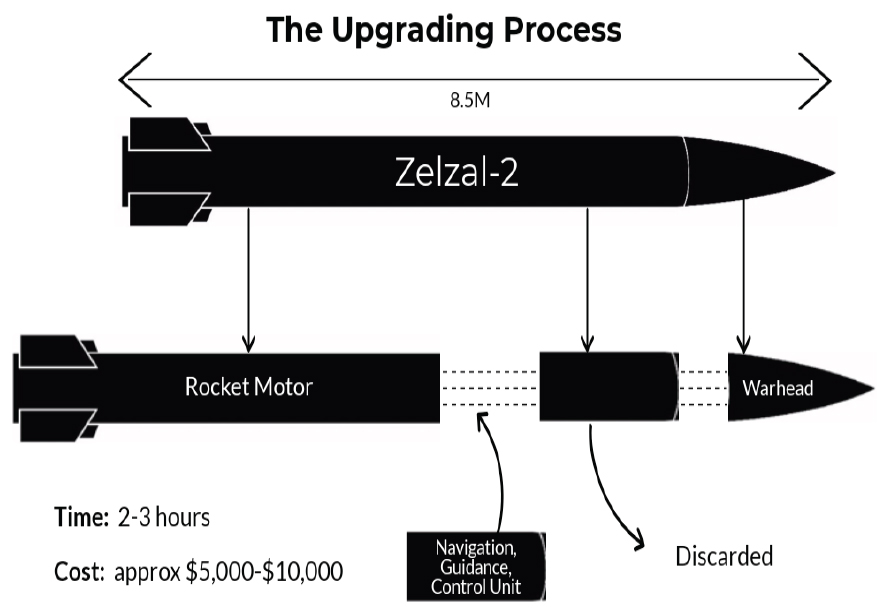 • Experts estimate that in a prepared facility, a trained crew could refit one missile in as little as a few hours, though the refit does require specialist equipment, many components, and technical sophistication. The IRGC reportedly established a special department in its Imam Hussein University in Teheran – its official military college which hosts weapons research and development facilities – to train hundreds of Lebanese specialists in producing arms. A former senior Israeli official told BICOM he believed many had likely returned to Lebanon.
• Experts estimate that in a prepared facility, a trained crew could refit one missile in as little as a few hours, though the refit does require specialist equipment, many components, and technical sophistication. The IRGC reportedly established a special department in its Imam Hussein University in Teheran – its official military college which hosts weapons research and development facilities – to train hundreds of Lebanese specialists in producing arms. A former senior Israeli official told BICOM he believed many had likely returned to Lebanon.
• The components, which are relatively light, are transported from Iran to factories in Syria and Lebanon, either via land, or by air via Damascus, using civilian planes leased from private Iranian companies by the Iranian Revolutionary Guard Corps. These include a civilian, commercial Qeshm Fars Air Boeing 747, identified in media reports citing US and Israeli officials. Arms shipments are often stored in the Damascus airport before being transported to Lebanon, or to Iranian army bases in Syria.
• According to a report in the Kuwaiti newspaper Al-Jarida in March 2017, IRGC commanders acknowledged building factories for Hezbollah to manufacture both missiles and firearms in Lebanon. According to the report, Hezbollah assumed full control over them in December 2016. The sites are located 50 metres underground and protected by multiple layers of defences from aerial bombardment.
• Several sites in Syria targeted by the Israeli Air Force (IAF) have been part of the Precision Missile Project, according to defence officials cited in Israeli media. Whilst Israel has not similarly targeted facilities inside Lebanon, it has used public revelations of intelligence about these sites to expose them. In early February 2019, Israel’s Channel 12 reported Israel had identified a new factory to produce precision missile parts near the northwest Syrian city of Safita.
How many precision missiles does Hezbollah currently have?
• Israeli experts estimate that Hezbollah aspires to acquire an arsenal numbering in the hundreds or even low thousands, by developing an industrial scale capacity within Lebanon, working with components shipped from Iran. Hezbollah leaders claim they already possess the ability to strike strategic targets all over Israel.
• Israeli officials believe that Hezbollah currently only possesses a small number, potentially 20, thanks to Israel’s intensive efforts in uncovering the factory sites and targeting weapons on route. In December 2018, outgoing Chief of Staff Gadi Eisenkot told the New York Times: “As we speak Hezbollah does not possess accurate [missile] capabilities except for small and negligible ones… They were hoping to have hundreds of missiles in the mid- and long-range.” Iran’s financial resources are also squeezed due to the reimposition of nuclear-related sanctions by the US.
• Other experts BICOM spoke to have estimated Hezbollah already has approximately 200 precision missiles. According to this estimate, Hezbollah could already cause a significant amount of damage to Israel. Hezbollah is likely working under the assumption that the more the group possesses, the lower the chance Israel would consider a pre-emptive strike to destroy the threat before it can be used.
What threat do precision missiles pose?
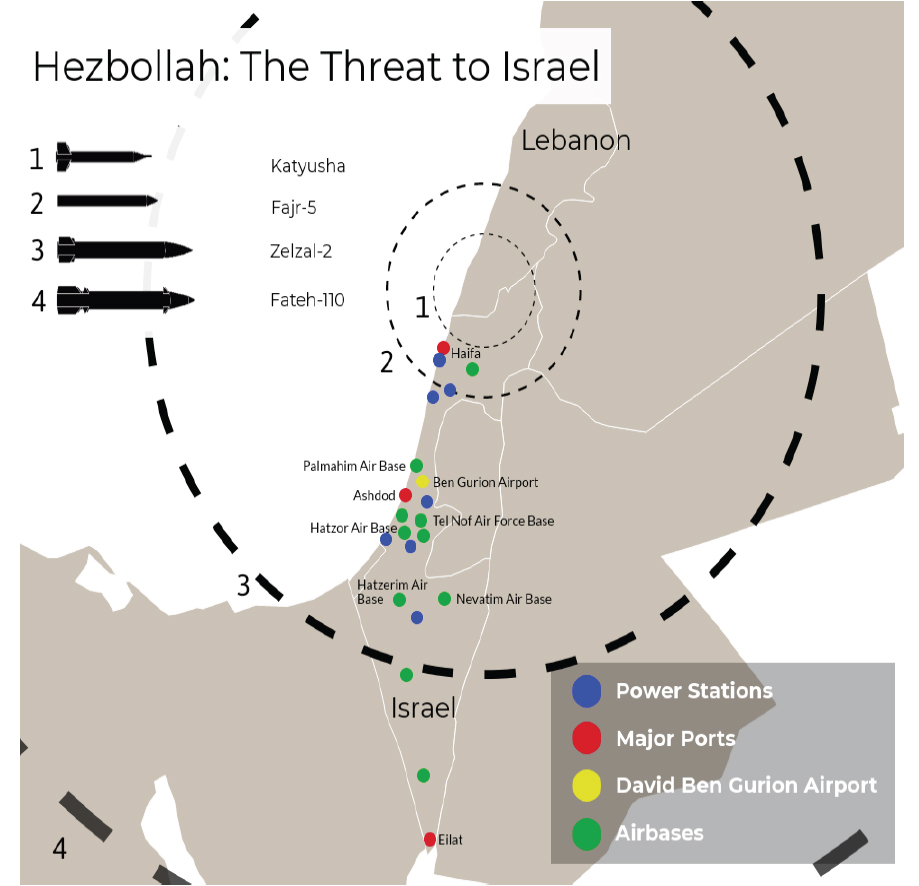 • The precision missiles can do significant damage to Israel’s critical infrastructure and urban centres. Mike Elleman, senior fellow for missile defence at the International Institute for Strategic Studies has calculated that 20-40 precision guided missiles such as the Fateh-110 – which has a CEP (“circular error probable”, a measure of missile precision) of 100m, weighs 3,450kg and has a range of 300km – would destroy a specific, hardened military target with 75% confidence. If Iran has managed to reduce the CEP of its missiles to 50m, as some believe, only ten Fateh-110s or equivalent would be needed. For softer targets such as urban centres the number of missiles required further decreases.
• The precision missiles can do significant damage to Israel’s critical infrastructure and urban centres. Mike Elleman, senior fellow for missile defence at the International Institute for Strategic Studies has calculated that 20-40 precision guided missiles such as the Fateh-110 – which has a CEP (“circular error probable”, a measure of missile precision) of 100m, weighs 3,450kg and has a range of 300km – would destroy a specific, hardened military target with 75% confidence. If Iran has managed to reduce the CEP of its missiles to 50m, as some believe, only ten Fateh-110s or equivalent would be needed. For softer targets such as urban centres the number of missiles required further decreases.
• Whilst experts disagree about just how precise Iranian missile technology has become (Iranian claims of 10m CEP are doubted by Western analysts), the exact figure is not critical, since the warheads a Fateh-110 can carry could do significant damage even landing 30-50m away, depending on how many are fired, and how well protected the target is.
• Israel is a small, densely populated country, depending on relatively few key infrastructure sites. Its most populated cities, as well as all its critical infrastructure, are located in an area just 20km wide and 80-100km in length. The country has just 12 power stations, three commercial ports (Haifa, Ashdod and Eilat) and one main international airport (Ben Gurion). In 2013, Hezbollah’s leader Hassan Nasrallah threatened to “launch missiles at several power-stations” to “shroud the whole country in darkness.” In December 2018, Hezbollah published a propaganda video clearly signalling precision capabilities. Nasrallah warned Israel from attacking, with his speech overlaid with satellite images and precise coordinates of significant strategic sites inside Israel, including:
- Palmahim Air Force Base, home to helicopter and Unmanned Aerial Vehicle squadrons, as well as long-range Jericho missiles and Israel’s space satellite launch pad.
- Tel Nof Air Force Base.
- Nevatim Air Force Base, home to five squadrons including Israel’s new F35’s.
- Hatzor Air Force Base.
- The nuclear reactor near Dimona.
- The Haifa oil refinery.
- The ‘Kirya’ Ministry of Defence and IDF Headquarters in central Tel Aviv.
• Targeting Israel’s air force bases could interrupt air force operations, blunting Israel’s primary weapon for targeting and destroying missile launchers. Radar stations, which are critical to Israel’s missile defences, are also vulnerable, as are concentrations of troops mobilising for ground operations, and Israel’s offshore gas facilities.
The regional threat of Iranian precision-guided technology
• Over the last decade, Iran has replicated its Hezbollah militia model to other allies in the region, often learning and adapting its methods to make it more covert and harder to detect. One example is the proliferation of precision-guided technology to the Houthi rebels in Yemen, which presents a real threat to Western interests in the region. In October 2018, Houthi forces launched a precision missile called the Badr P-1 – which had visible similarities to the Fateh-110 and Zelzal – near Al Hudaydah, reportedly killing four Sudanese soldiers of the coalition of Arab military forces.
• Although Iran has officially denied all allegations surrounding involvement with the Houthis, UN experts claimed to have identified missile remnants, related military equipment and military unmanned aerial vehicles that are of Iranian origin within the rebel group’s arsenal. In early 2018 the Houthis used missiles called Burkan-1 and Burkan-2, almost an exact replica in range and shape as the Iranian Qiam-1 missile.
• The proliferation of precision-guided missiles and the ability to convert standard missiles to precision-guided missiles represents a significant upgrade to the military capability of non-state actors and this has forced Western states with interests and armed forces in the region to invest more in missile defence technology. It is only a matter of time until the capability and technology currently being utilised by Hezbollah in Lebanon is shared with other Iranian allies in the region including Shi’ite militias in Syria and Iraq. Were these capabilities to become widespread it would constitute a very serious threat to US and UK armed forces operating in the region.
ISRAEL’S RESPONSE TO THE PRECISION MISSILE THREAT
How has Israel targeted arms convoys and factories in Syria?
• Shortly after the outbreak of the Syrian civil war – in which Israel generally sought to avoid entanglement – Israel declared the supply of advanced missiles to Hezbollah to be a ‘red-line’ and vowed to prevent the supply of what it called strategic ‘tie-breaking’ weaponry, including precision-guided missiles. Israeli security officials have confirmed hundreds of sorties on targets in Syria, particularly at the Lebanese border crossing, to prevent Hezbollah obtaining this capability.
• These targets included storage facilities, weapons convoys, and research and production facilities such as a site in Hisya, south of Homs near the Lebanese border (targeted in November 2017); a research and development facility in Jamraya near Damascus, (targeted in February 2018), and a site near Latakia, (targetted in September 2018). This has formed part of a wider campaign against Iranian forces and proxies being built up in Syria, with Israel admitting that it dropped 2,000 bombs in 2018.
• This campaign involved sensitive coordination with Russia. Israeli Prime Minister Benjamin Netanyahu has invested heavily in securing Russian acquiescence to Israeli operations over Syria, and Israel has established de-confliction mechanisms to avoid clashing with Russian planes or air-defence systems. This de-confliction encountered a major crisis in September 2018 when a Russian military aircraft with 15 crew was destroyed by a Syrian anti-aircraft missile fired at Israeli jets on a raid against an Iranian missile factory in Syria. The Russian military blamed the IAF for the incident and decided to provide the advanced S-300 anti-missile system to Syrian Government forces. Since then, Israel has been more cautious in its operations over Syria.
Why has Israel used public intelligence revelations to address precision missile facilities in Lebanon?
• Since mid-2017 Israeli political and military leaders have spoken with increasing frequency about Hezbollah’s precision missile project within Lebanon, both publicly and in private with international interlocutors. Unlike in Syria, Israel is reluctant to carry out airstrikes in Lebanon, which could attract international condemnation and risk triggering a conflict with Hezbollah. Instead, Israel has used public warnings including revealing secret intelligence to maximise impact. Netanyahu utilised his September 2018 speech to the UN General Assembly to reveal Israeli intelligence satellite pictures of three factory sites north of the Beirut International Airport: one under a soccer field used by a Hezbollah-sponsored team; one immediately north of the airport; and one underneath the adjacent Uza’i waterside neighbourhood. In mid-December 2018 Netanyahu said Hezbollah had shut down those sites after Israel exposed them.
• The Israeli Government would like to see the Lebanese Government and Lebanese Armed Forces, which are backed by Western political and economic support, as well as the United Nations Interim Force in Lebanon (UNIFIL), take action against Hezbollah and Iran’s precision missile project.
Does Israel have the option of a pre-emptive strike inside Lebanon?
• Israeli political and military leaders frequently take the opportunity to convey the extent of their intelligence to Hezbollah, as well as emphasising Israel’s readiness and capabilities to strike at the group’s capabilities.
• However, the option of a pre-emptive strike inside Lebanon presents a sharp dilemma for Israeli decision makers. Israel has a legacy of pre-emptive military action against strategic threats, including its successful destruction of nuclear reactors in Iraq (1981) and Syria (2007). The significance of the threat of precision missiles makes a pre-emptive strike inside Lebanon an option for Israeli decision makers, were they to gain intelligence that Hezbollah was acquiring a significant arsenal. However, any such pre-emptive strike would almost certainly lead to a major violent conflagration that both sides are loathe to undertake.
How effective are Israeli missile defences?
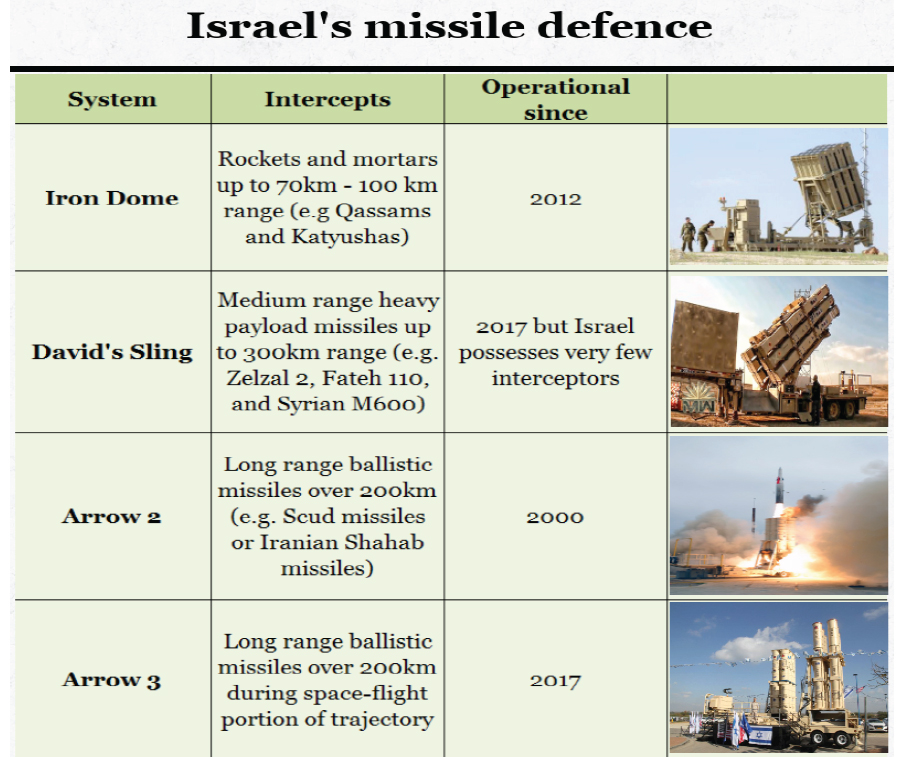 • Israel has been developing missile defence systems since the 1980s, to address the long-range ballistic missile threat, especially from Iraq and Iran. Israel now has a multi-layered missile defence system coupled with highly advanced radar systems. On Jan. 18, 2016, speaking at a Tel Aviv conference on national security, Israel’s then Chief of Staff Gadi Eisenkot outlined the future force structure of the IDF. Prominent among them was a “four or five tier missile defence system that will provide Israel with the most advanced capability in the world.” The system includes several elements in various stages of development and deployment (see diagram opposite).
• Israel has been developing missile defence systems since the 1980s, to address the long-range ballistic missile threat, especially from Iraq and Iran. Israel now has a multi-layered missile defence system coupled with highly advanced radar systems. On Jan. 18, 2016, speaking at a Tel Aviv conference on national security, Israel’s then Chief of Staff Gadi Eisenkot outlined the future force structure of the IDF. Prominent among them was a “four or five tier missile defence system that will provide Israel with the most advanced capability in the world.” The system includes several elements in various stages of development and deployment (see diagram opposite).
• Whilst Israel’s capabilities in missile defence are arguably the most comprehensive and capable in the world, they cannot provide hermetic protection. Missile interception systems can potentially be overwhelmed by multiple launches and decoys. If enough precision missiles were fired at a target it is assumed that some will inevitably get through. Though Israel’s radars can distinguish missiles heading for critical infrastructure and/or urban centres (which it can intercept) from those which will fall in open areas (which it can ignore), missile interceptors are still extremely expensive to deploy, in comparison to the missiles they are defeating, especially the short-range missiles. With limited batteries available, Israel may have to prioritise the defence of critical infrastructure from precision missiles and leave population centres more exposed.
• Missile defence also includes strengthening critical infrastructure, and the IDF Home Front Command and government ministries have carried out fortification work to secure several strategically vital sites against missile attacks. Representatives of government ministries and Israel’s National Emergency Management Authority formulated a classified list of key sites that required reinforcement materials, with the process guided by an evaluation of each site’s importance to the country’s ability to continue to function during an emergency. A source from the Home Front said that “each site is fortified in accordance with the threat posed to it” while emphasising that “this is about improving survivability… there is no such thing as 100 per cent protection.”
• In a military conflict with Hezbollah, Israel’s defence would also include intensive air force operations over Lebanon to disrupt Hezbollah’s ability to coordinate fire, prevent the simultaneous launch of large numbers of missiles and ensure the location of missile launchers are destroyed immediately after their detection.
What is the significance of the IDF’s new ‘missile corps’?
• In January 2018 Israeli media reported a government decision to establish a new force of precision ground-to-ground missiles with a range of up to 300km, which would provide an alternative to the air force for precision strikes against enemy targets including missile launchers. The decision was taken by then Defence Minister Avigdor Lieberman together with then Chief of Staff Gadi Eisenkot. The new corps is intended to provide an alternative strike capability in case the air force is hampered by precision missile attacks on its bases.
Does Israel have the capability for jamming or spoofing of GPS guidance?
• Another potential form of defence against precision missiles is jamming, which can interrupt the capacity for devices within a specific area to communicate with navigation satellites, denying them the ability to target accurately. Independent experts remain uncertain to what extent Israel has the capacity to do this with missiles from Lebanon, and whether jamming could also interrupt the IAF’s ability to strike back. In addition, jamming will only interfere with the accuracy of the missile in its final stages, and an incoming missile could still do significant damage in a populated area, even if it were prevented from hitting its intended target.
WHAT CAN BE DONE?
The US and key European states, including the UK, France and Germany, can play an important role preventing an escalation in Lebanon. One option would be to publicly warn Hezbollah and the Lebanese Government that they are aware of the precision project and to make clear that the project is a direct violation of UN Security Council Resolution 1701. If these warnings fail to make an impact then they should consider initiating tough sanctions against those involved in the project from Hezbollah and the IRGC.






